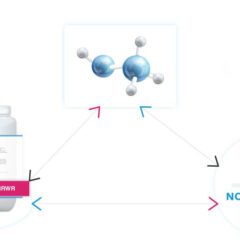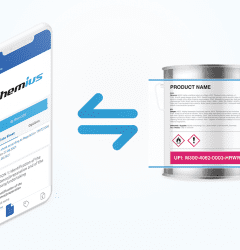26 Nov

Cloud-based web applications offer substantial benefits for the digital transformation of the chemical industry. © iStock/Bens Consulting
Digitally Transformed Processes in the Chemical Industry
When it comes to digitalization in the chemical industry, we often hear that our industry is special and that implementation costs often exceed the benefits. But, interestingly, precisely because of its specifics, it offers countless opportunities for successful digital transformation. Recent research in real-life digital transformation cases shows substantial benefits for organizations, the entire supply chain, and the environment.
Imagine that you are working with a team on a vital project, developing a new product that is key for reaching your growth goals for the year. Your colleagues in charge of laboratory testing work tirelessly to get valuable data on various formulations. They measure many parameters and collect their findings on a spreadsheet. Finally, after thorough testing and a long wait, the result lands in your inbox. You open the report eagerly, but when you do you are confronted with a huge, sprawling, unwieldy spreadsheet that stretches over many pages. You want to make your own analysis, compare data against previous projects, add some columns and formulae, draw charts, but the problem is that the spreadsheet is in PDF form. You can’t do any of the analysis you want to and put the data to use. This is frustrating and unnecessary as there are far better uses of your valuable time.
You mail to your colleagues and ask them to send you the spreadsheet as an Excel file, they say that this is not possible: the data can only be saved as a PDF file. Therefore, the only way to make use of the data is to transcribe the spreadsheet manually — which is frustrating.
I’ve heard countless anecdotes of cases like this happening in companies around the world. It seems to be such a fundamental problem that it should have been overcome long ago, and yet it remains the norm, not the exception. In many organizations, data is kept in various formats, scattered over various business functions and units. As soon as we move outside of that organization, only PDFs are sent from one company to another. The PDF is the primary medium for exchanging data, information, and knowledge in the supply chain.
On the supply side, a significant amount of effort is put into gene-
rating data and creating documents, as well as getting those documents to customers. On the customer side, the same level of effort is required to extract — which too often means manually transcribing — information from documents (usually PDFs) into usable and processable data. Moreover, it happens at every step in the supply chain and at every organization within it. Instead of focusing on creative work, highly educated experts are doing non-value-added work: copying PDF information into Excel.
The Chemical Industry Is Unique
In the chemical industry, formulators combine various ingredients from multiple suppliers to create a new product. Therefore, the output data of the supplier represents vital input data for the next company in the supply chain.
Raw material properties and parameters are important for a formulator when deciding which materials to use in their next project. Health and safety information (hazards, the presence of substances of very high concern, etc.) is vital for a health and safety expert to develop measures for the protection of workers using the new product. Knowing the concentration of volatile organic compounds (VOCs), ozone-depleting and other environmentally hazardous substances is essential for environment protection experts when assessing risks for the environment. Product information, like properties and parameters, is essential for a marketing expert when preparing or updating a catalog, a website, or a web shop.
All this data and information is product-related. For example, raw material (product) information is vital for producers of mixtures, while mixture information is relevant to companies down the supply chain. More importantly, this data is required in most business functions, including but not limited to R&D, health, safety and environment, marketing and sales, storage, logistics and so on.
How Digitalization Can Help
In general, digitalization means a process of leveraging data to improve (business) processes. In other words: no data — no digitalization!
This definition suggests that the chemical industry must first shift its focus from creating and sending documents to exchanging data and information. Documents must not be the focus but rather side products of digital transformation. Moving towards data exchange opens the doors to substantial time and cost savings and helps to reduce waste.
“Digitalization means a process of leveraging data to improve (business) processes. In other words: no data – no digitalization!”
Where to Start
Recently, two digital tools that can save time and money and help protect the environment caught the attention of researchers. Allchemist is a cloud-based web application that connects suppliers, formulators and downstream customers in the same digital environment. On the supply side of Allchemist, suppliers of raw materials digitize their materials and share them with formulators. On the demand side, formulators develop and optimize formulations using digitized raw material information in the shared database.
While Allchemist is for R&D experts, Chemius was developed with environment, health and safety (EHS) experts in mind. When a formulator creates a formulation in Allchemist, it automatically appears in Chemius. This allows the EHS team to directly use digitized formulation data to automatically create digital safety data sheets, safety instructions and labels — all within seconds. When done, they can easily share them with customers. This way, teams and customers work in a shared environment without sending documents back and forth.
Significant Time and Cost Savings
Recent research on digitizing the paints and coatings development process using Allchemist as a technical enabler for improved process shows a 48% shorter throughput time for the entire process when compared to a conventional one. The substantial reduction was achieved due to a 70% reduction of non-value-added activities.
Major results normally come at a high price. This raised the question of whether the faster development process also reduces process costs, or whether these actually increase due to implementation costs. A special study was therefore carried out to determine the implementation costs. The researchers showed that the renewed, faster process is also significantly cheaper than the conventional one. The costs were reduced by 48%.
Benefits for Suppliers
The above results and benefits directly apply to formulators who are on the demand side. But what are the benefits for suppliers? What can they expect in return for providing the data? The most obvious benefit is that they help their customers to be more efficient. As a result, the customers will likely do more business with them. The second reason, which is not so obvious, is that they can shorten their sales cycles. Another research project demonstrated that the digitally formatted sales process by using digital tools can be shortened by up to 32%. Simultaneously, more potential customers can be accessed using the common technology. Interestingly, the authors of this study suggest that a digital sales channel is different from an online sales channel (e-commerce). The latter is 15.9% faster than the personal “call me, mail me” channel and comes in handy for customers when buying already well-known products (commodities). However, when they decide to make their first purchase, they need reliable and detailed product information. This is where a common technical tool like Allchemist, which allows customers to access all product information and formulate online, makes a difference.
As a result, the digitally supported sales channel is 32.1% faster than the personal sales channel and 16.3% faster than the online sales channel.
Last but not least, digitally transformed processes also help reduce waste. Therefore, they contribute to cleaner environment efforts, which are at the center of the European Green Deal and its Chemicals Strategy for Sustainability.



Bojan Buinac